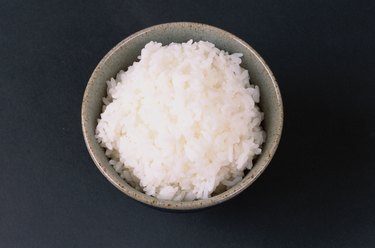
Rice, especially brown rice, is a popular diet food staple. However rice by itself can be pretty bland for some people. If you're looking for a low-calorie sauce that will make your rice more lively while not sabotaging your caloric intake, there are several choices you can pick from.
Hot Sauces
Video of the Day
If you're a fan of spicy foods, hot sauces may be the ideal match for a bowl of rice. Many hot sauces are made with a vinegar base, with spices and flavoring added. As some types of vinegar have almost no caloric content, and the added spices don't add many, if any, calories to the sauce, some sauces are a zero-calorie condiment. For example, one nationally sold brand of hot sauce has zero calories per serving, along with zero carbs, protein and fat.
Video of the Day
Soy Sauce
For many people, rice and soy sauce go together like bread and butter. While soy sauce does have calories, it has far fewer calories than many other sauces. A tablespoon of a nationally sold brand of soy sauce contains 11 calories. It also contains two grams of protein, but also a whopping 1,005 milligrams of sodium, which can cause you to retain water and temporarily gain weight. However, you can also find low-sodium soy sauces that help you limit your sodium intake.
Salad Dressing
If you're looking for a wider selection of flavors and tastes, you can also consider a range of salad dressings for rice salad recipes. While many salad dressings are notorious for their calorie and fat content, there are low-calorie, low-fat alternatives as well. For example, a low-calorie generic brand of Caesar dressing has 17 calories per serving and a moderate 162 milligrams of sodium.
Servings
Regardless of the kind of sauce you choose for your rice, always pay attention to the nutritional information posted on the container. Manufacturers have to include information such as the number of calories in a serving, as well as its protein, carbohydrate and fat details, as well as the presence of certain minerals such as sodium. However, the Food and Drug Administration regulations only requires the manufacturer to list this information based on serving sizes, and there may be multiple servings per container. Always keep track of how many servings you use if you're counting your calories and nutritional intake.
- myfitnesspal: Calories in Frank's Red Hot (Since 1920) Original Cayenne Pepper Sauce
- USDA National Nutrient Database: Soy Sauce Made from Soy (Tamari)
- myfitnesspal: Calories in Salad Dressing - Caesar, Low Calorie
- U.S. Food and Drug Administration: How to Understand and Use the Nutrition Facts Label